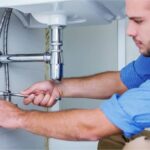Faucets are an indispensable part of our homes, offices or any place that has a water supply. However, they can become a nuisance when they start leaking. A dripping faucet not only escalates your water bill but may also cause significant water wastages over time. This blog will systematically guide you through the journey of diagnosing and fixing leaking faucets, saving you time, money and aiding environmental conservation.
Identifying Faucet Leaks
Before embarking on the journey to repair the dripping faucet, determining whether there is a leakage is essential. Generally, a dripping tap is the most obvious sign of leakage. However, sometimes the leak may be not visible immediately and can quite effectively contribute to water wastage if not checked in time. Checking for abnormally high water bills or abnormal sounds from the faucet might suggest an underground leaky pipe or a worn-out washer.
Ferguson’s Plumbing Information
If you need guidance concerning plumbing matters, reaching out to professionals may come in handy. You can effortlessly Reach Fergusons Plumbing Group via LinkedIn. These professionals have experience dealing with all types of home systems making it easier for you to understand how faucets works and potential leak triggers need attention.
Type Of Your Faucet
The design of each faucet varies significantly from one another even though they serve the same primary function which is controlling the flow of water. The primary types include ball faucets, cartridge faucets and disc faucets among others. Identifying your type of faucet is a crucial factor when seeking to solve its leakage mystery as this classification guides your troubleshooting process.
Gather Necessary Tools
Having identified your type of faucet, you should gather the tools necessary to fix the leak. Common tools for handling a majority of faucets consist of adjustable wrenches, Phillips head screwdrivers, trim and handle screws amongst others. You might also need to get replacement parts if necessary such as O-rings or cartridges.
Ensure Water Supply Shut-off
For safety purposes and preventing water wastage, you should close your water supply system before starting repairs. The level of shut-off depends on the location of your repair and may range from local shut-off valves to main water supply points.
Disassemble Faucet Handle
Disassembling the faucet is usually necessary when addressing leaks. It allows you to reach deep-lying parts that often are responsible for drips. The disassembly process varies for different types of faucets, so you should make sure to remember how each part was originally positioned or use a guide for reference.
Examine Inner Parts
While having disassembled your faucet, it is advisable to check for rusty or worn-out faucet parts such as washers, valve seats or seals. These worn out parts are common causes of faucet leaks and if found should replace them with suitable substitutes from local hardware stores.
Clean Valves And Replace Parts
In some cases, cleaning up can restore the functionality of the faucet without replacing any part. Here, rundown parts soaked in vinegar/detergent blends help eliminate scales/corrosion. If cleaning does not work, replacement with new ones is essential.
Assembly Process
After inspecting and addressing faulty inner parts, reassemble your faucet to its initial state following either your memory or assembly guide correctly. Then gently tighten all components without using overweight to prevent any part breakages.
Assess The Repaired Faucet
Turn on the water supply to evaluate whether the faucet leak problem has been solved. Keenly check for drips, especially conditions returning back post-repair as these may indicate that you overlooked some leaks.
Professional Help Advantage
If all your efforts do not result in a leak-free faucet, seeking professional help is a sensible step. Expert plumbers have wider access to parts and have an extensive understanding of intricate systems. This enables them to conveniently address persistent leaks that may be tricky for non-professionals.
Leak Prevention Measures
Maintaining your faucet well can actually save you from trouble of having to fix a leaking faucet. Often this involves softer treatment of the faucets by not turning them off too vigorously which oftentimes results in wear and tear.
A Learning Advancement
Faucet repair does not only provide potential ways of addressing future leaks but also helps one understand the working of faucets which in itself is a rewarding experience. So, even if things do not go as planned, take it as a learning experience.
Towards a Leak-Free Future
Total care while operating the faucets coupled with regular check-up accords faucets longer life spans and troubles free operation. The mystery might seem tough in the beginning, but once you get the hang of it, maintaining your water-flow fixtures becomes manageable and economically fruitful, making you a responsible water steward at your home or workplace.







